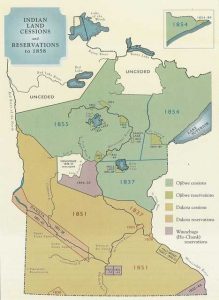7 Treaty Making in Minnesota

A big part of the story from when Zebulon Pike arrived in the region in 1805 and when Minnesota became a state in 1858 is how the land changed hands. Throughout the nation, the federal government acquired land from American Indians by making treaties – over 400 of them from the earliest years of nationhood until the 1870s when the process was ended by an Act of Congress. In Minnesota some 17 treaties transferred land ownership from the Dakota and Ojibwa to the United States – most concluded between 1837 and statehood in 1858.

The treaty making process was unfair and plagued with problems that left the Dakota and Ojibwe with little choice but to sign. Some of these issues included: differing concepts of land ownership, an unequal balance of power, problems and corruption in interpretation, differing structures of leadership, and the failure in many cases of the U.S. government to meet agree-upon treaty obligations. The lecture that accompanies this chapter will take an in-depth look at these issues and closely review two treaties in Minnesota. When listening to the lecture, you will be asked to complete a review packet that will help you make sense of the general issues with treaty making and the details behind two crucial treaties concluded in Minnesota. In the meantime, here is a list of some treaties I’d like you to be familiar with:
- 1805 – Zebulon Pike Treaty. In this treaty, the Dakota agreed to sell 100,000 acres at the confluence of the Mississippi and the Minnesota Rivers. In the 1820s the U.S. military constructed Fort Snelling at this location, it includes much of today’s Twin Cities.
- 1825 – Prairie Du Chien Treaty. This treaty established boundaries between American Indian nations, making it easier for the government to negotiate for land cessions later.
- 1837 Treaty with the Chippewa. This treaty transferred land in east central Minnesota and northern Wisconsin to the federal government. This is one of the treaties reviewed in our lecture.
- 1851 Treaty with the Sioux – Sisseton and Wahpeton Bands. This treaty is one of two treaties in 1851 that transferred nearly all the land in southern Minnesota from the Dakota to the federal government. This is one of the treaties reviewed in our lecture.
- 1858 – Treaty with the Sioux. This treaty is conducted in Washington DC and forces the Dakota to relinquish the portion of their 1851 reservation north of the Minnesota River.
The Treaty of Traverse des Sioux
Like the painting of Father Louis Hennepin we studied in our chapter on European exploration, this 1905 painting by Francis Davis Milletor depicting the 1851 treaty negotiations of the Treaty of Traverse des Sioux, hung in the Governor’s Reception Room at the Minnesota State Capital. For many years countless Minnesotans viewed the painting without any historical context. The scene the image presents inaccurately depicts a painful episode in Dakota history. The painting has since been moved to a gallery inside the capital that allows for interpretation that provides historical context for the image. Take some time to view the image and watch the commentary below. What are your thoughts about the painting and the Minnesota Historical Society’s decision to remove the image from the reception room but keep it displayed in a separate gallery?
The Treaty of Traverse des Sioux (1851) between the Sisseton and Wahpeton bands of Dakota and the US government transferred ownership of much of southeastern Minnesota Territory to the United States. Along with the Treaty of Mendota, signed that same year, it opened twenty-four million acres of land to settler-colonists. For the Dakota, these treaties marked another step in a process that increasingly marginalized them and dismissed them from the land that had been—and remains—their home.
Eric Weber, MNOpedia - https://www.mnopedia.org/event/treaty-traverse-des-sioux-1851

